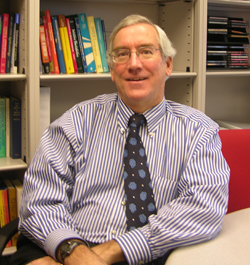 |
James Anderson, Ph.D. |
NOTE: This profile is part of a series highlighting the 26 researchers who were named UNMC Distinguished Scientists or New Investigators for 2007. Each of these researchers will be profiled in UNMC Today leading up to a March 20 ceremony to recognize their achievements.
- Name: James Anderson, Ph.D.
- Title: Professor
- Joined UNMC: 1989
- Hometown: Farmingdale, N.Y.
Briefly describe your research in laymen terms, please.
I collaborate with medical researchers — primarily clinical oncologists — on the design, conduct, analysis and reporting of research — especially clinical research.
What led you to pursue this area of research?
After undergraduate training in algebra and number theory, I did my doctorate in biostatistics at the University of Washington, where the focus was on statistical methods applied to clinical research. I chose to pursue a career in clinical research so I could work collaboratively to improve therapies to treat disease. I’m proud that my collaborations with colleagues in pediatric cancer research have led to substantial increases in the cure rates for many childhood malignancies.
How do you see your research contributing to science?
My collaborations are designed to maximize the chance of discovering new treatment approaches, which truly improve disease outcome.
Why did you become a scientist?
I found that I could use my love of mathematics to apply quantitative methods to the evaluation of therapeutic approaches to disease treatment.
What is your hope for the next generation of scientists?
My hope is that the advancements in genomics research, including those using gene expression microarrays and single nucleotide polymorphism (SNP) chips can be rapidly moved into routine use in clinical research, allowing the development of more rational treatment approaches for specific subsets of patients.
Beyond grant funding, how do you measure success?
I measure success by how often my collaborations with clinical and other colleagues lead to moving their research agendas forward.
What would you tell a student interested in a research career?
That while it can occasionally be frustrating and exasperating, ultimately it is incredibly rewarding in terms of both the friends and colleagues made and the progress made in understanding and treating (ultimately curing) the diseases you study.
Do you have a hero/role model? If so, what do you admire most about them?
My hero/role model is Emil (Tom) Frei III, one of the fathers of modern cancer chemotherapy. Tom believed that cancer could be cured with drugs at a time when most thought the idea crazy and saw that the way to greater cure rates was through the comparison of alternative treatment approaches (many developed by him) through randomized clinical trials.
Tell us about your family and hobbies outside of the lab.
My wife, Magda Peck, is a public health educator and scientist at UNMC. Our sons, Samuel and David, are both Omaha North Vikings. Sam is a sophomore at the University of Iowa and David is a senior at North who hopes to attend Georgetown or Berkeley in the Fall of 2008. I love classical music, great wine, biking and travel. My perfect day would begin with a day hike above Zermatt, followed by dinner of rachette and rösti (accompanied by a glass of Dole) and music by Rachmaninov and Sibelius.
List three things few people know about you.
- I sang Brahm’s Ein Deutsches Requiem with Michael Tilson-Thomas and the Buffalo Philharmonic;
- I acted in community theater, including playing the role of Adam in “Adam and Eve” from The Apple Tree; and
- I was first author of the paper reporting the first randomized clinical trial in childhood non-Hodgkin’s lymphoma.